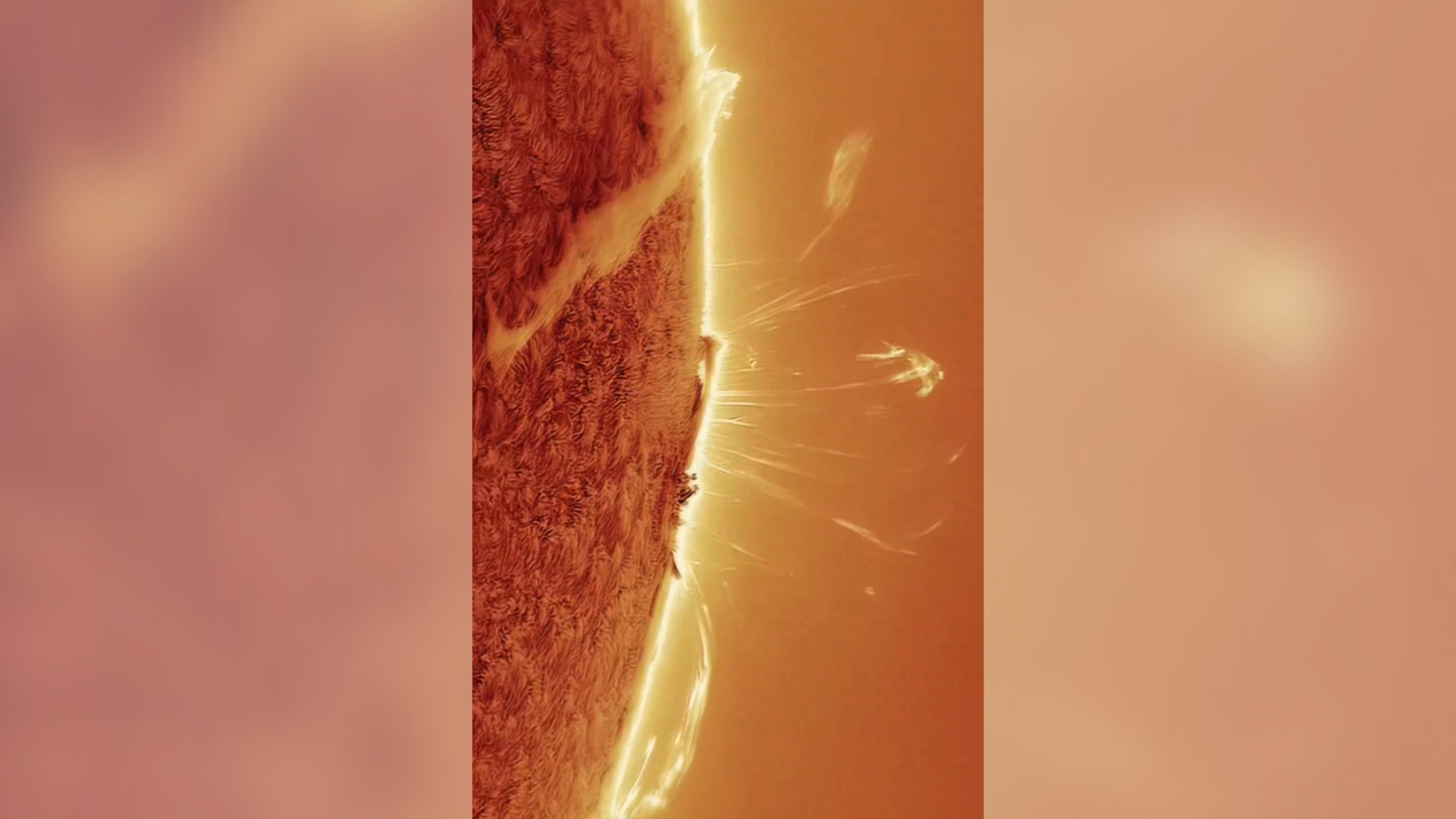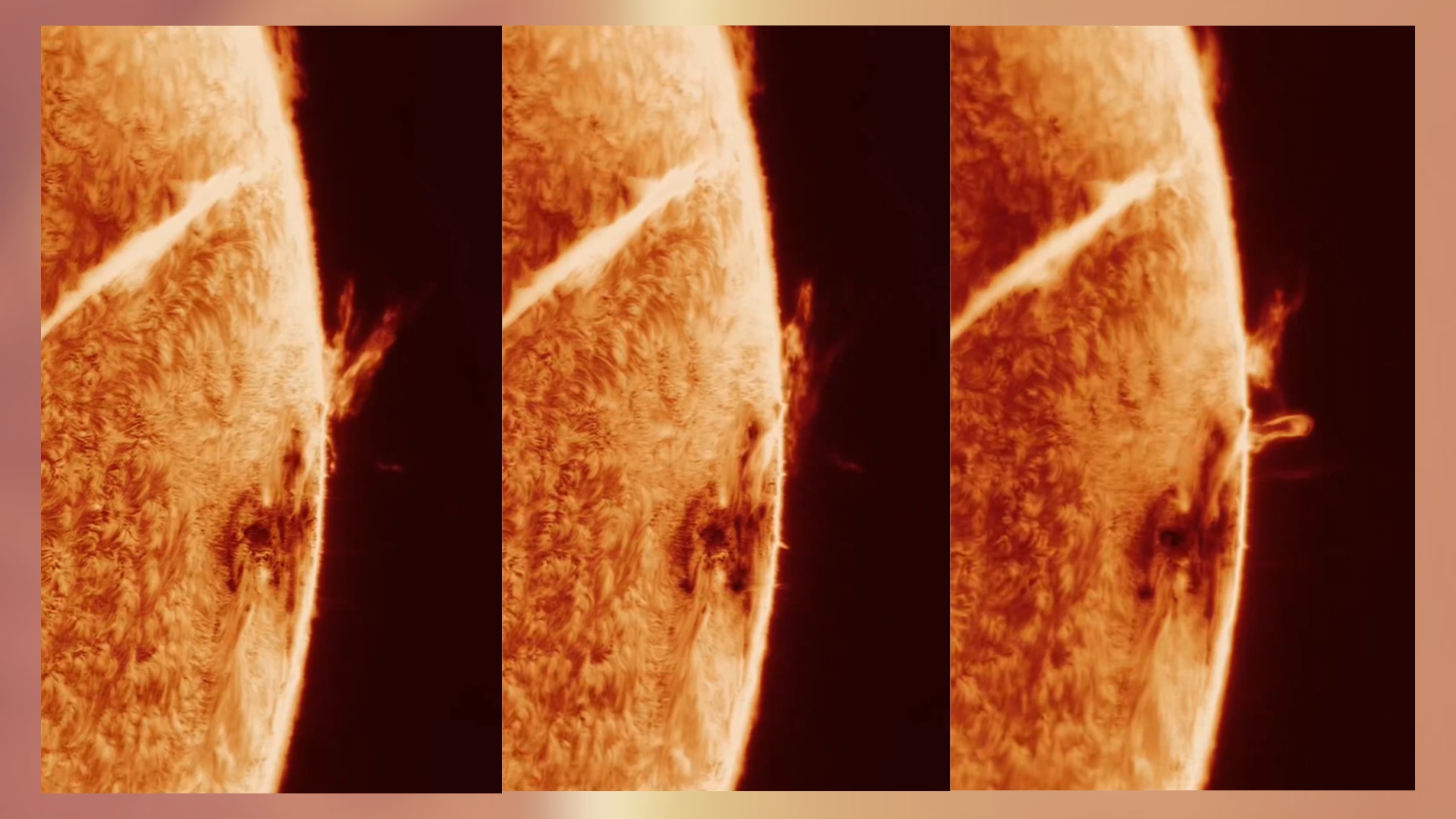
Astrophotographer Andrew McCarthy has been keeping a watchful eye on sunspot AR3697 as it appears over the sun's southeastern limb. The incredible footage, captured from his backyard in Arizona showcases the turbulent nature of the sunspot region in great detail.
"Unlike most celestial objects, the sun looks quite different from day to day, and is filled with exciting events like flares or coronal mass ejections. There's always something interesting to look at!" McCarthy told Space.com in an email.
The sunspot region, formerly known as AR3664, garnered the attention of media and skywatchers alike in recent weeks because, during its last transition across the solar disk, it sent a flurry of coronal mass ejections CMEs — expulsions of plasma and magnetic field — toward Earth. When these CMEs struck our planet's magnetosphere, a Category 5 geomagnetic storm (the most powerful class) was triggered, sparking auroras far beyond their normal ranges.
More unsettled space weather could be on the horizon as the sunspot region turns to face Earth in the coming days, and McCarthy has been documenting its return with daily timelapses and livestreams that he posts on X.
"This sunspot has a history of being highly active, and produced a number of flares and CMEs which are exciting to capture and track," McCarthy told Space.com in an email.
McCarthy first documented the sunspot region shortly after it fired off a colossal X-class solar flare, capturing the aftermath of the flare in remarkable detail.
"WOW! This is the same active region that caused those aurora a few weeks ago. It’s finished rotating around the back of the sun and ready to cause some havoc again!" McCarthy wrote in a post on X.
WOW! This is the same active region that caused those aurora a few weeks ago. It’s finished rotating around the back of the sun and ready to cause some havoc again! This is the aftermath of yesterday’s X class flare. pic.twitter.com/34auBgJyeIMay 28, 2024
During his third consecutive day of watching the historic sunspot as it began its journey back around to face Earth, McCarthy recorded plasma loops appearing to "dance" across the surface of the sun.

"This is a timelapse video I recorded over a period of roughly 90 minutes- you can watch how the sped-up plasma dances like flames…. Except the "flames" are larger than Earth." McCarthy wrote on X.
My 3rd consecutive day watching this now-famous sunspot as it swings back to be Earth facing. This is a timelapse video I recorded over a period of roughly 90 minutes- you can watch how the sped-up plasma dances like flames…. Except the “flames” are larger than Earth. pic.twitter.com/1J2XL9zY6qMay 29, 2024
A lot of hard work and planning goes into capturing such stunning views of our closest star. In a post on May 29, McCarthy gives us a sneak peek into the vast amount of processing that goes on behind the scenes.
"This is what it looks like when I manually align each tile of a solar mosaic. I do it manually because I get an intimate look at each panel- so I know if I need to go back and restack it." McCarthy wrote on X.
A large part of post-processing is removing atmospheric artifacts and adding color to increase the contrast and overall aesthetic of the image, according to McCarthy.
"Naturally the view through my telescope is red, but because of the nature of the highly filtered light I have to use a monochrome camera to capture it, thus color is added later," McCarthy told Space.com.
McCarthy has an impressive backyard set up which he has perfected over the years.
"My equipment is always ready to go, as I have built an observatory to house my solar telescope and have it ready at the push of a button," McCarthy told Space.com.
"Capturing the timelapse footage is simple, but it took a long time to learn how to do it effectively. That's where my years of experience have helped me!" McCarthy continued.
This is what it looks like when I manually align each tile of a solar mosaic. I do it manually because I get an intimate look at each panel- so I know if I need to go back and restack it. This is the part of astrophotography that is pretty tedious and turns a lot of people off. pic.twitter.com/yyoXpRM7cVMay 29, 2024
During McCarthy's fourth day of photographing the turbulent sunspot region, he captured more plasma loops twirling above the surface.

"You can see the aftermath of a flare: loops of plasma guided by the magnetic field," McCarthy wrote in a post on X.
McCarthy frequently goes live on both X (@ajamesmccarthy) and Instagram (@cosmic_background) to show how the sun looks in real-time. He has been photographing the entire sun in detail every day with the hope of releasing one of his highest-quality images in print. To keep up to date with the latest print releases you can join McCarthy's mailing list.
As this sunspot rotates to face Earth, the likelihood of possible geomagnetic storms increases. In fact, any CME released from a sunspot region when it is facing Earth has a higher probability of hitting our planet.
The key dates for when the sunspot region will reach its location of optimum Earth connection is around June 4 to June 6, solar astrophysicist Ryan French previously reported for Space.com. "Any significant eruptions during this time have the best odds of producing a geomagnetic storm and enhanced auroras displays here on Earth," French continued.
We will certainly be keeping our eyes peeled for more explosive action from AR3697 — and we certainly hope McCarthy will be doing the same.
I can't wait to see what else the sun has in store for us as solar activity continues to ramp up as we approach solar maximum, the peak period of solar activity during the sun's approximately 11-year solar cycle.







